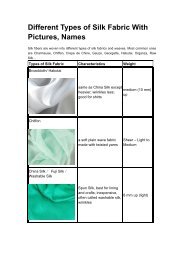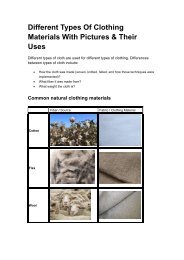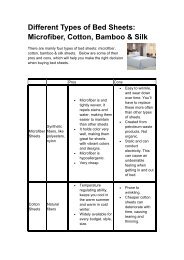Different Types Of Fibers With Pictures
Different Types Of Fibers With Pictures https://www.pandasilk.com/faqs/
Different Types Of Fibers With Pictures
https://www.pandasilk.com/faqs/
You also want an ePaper? Increase the reach of your titles
YUMPU automatically turns print PDFs into web optimized ePapers that Google loves.
<strong>Different</strong> <strong>Types</strong> <strong>Of</strong> <strong>Fibers</strong> <strong>With</strong><br />
<strong>Pictures</strong> & Their Properties<br />
What is a Fiber?<br />
All textiles are made up of fibers. <strong>Fibers</strong> include natural fibers (cotton, bast<br />
and leaf fibers, wool, silk) & synthetic fibers.<br />
General Properties of <strong>Fibers</strong>:<br />
• High length to diameter ration, fineness and flexibility<br />
• A certain level of strength<br />
• Extensibility and elasticity<br />
• Resistance to chemicals, heat and sunlight<br />
• Ability to be colored<br />
1. Cotton<br />
Cotton is the most common natural fibers in our daily life.
China, India, Egypt, Peru, Brazil, the United States are the world’s major<br />
cotton producing area.<br />
Yellow River, Yangtze River, south, northwest, northeast are five major<br />
cotton-producing regions of China.<br />
Cotton fiber structure<br />
Immature fibers exhibit thin wall structures and a large lumen ,whereas<br />
mature fibers have thick walls and a small lumen that may not be<br />
continuous ,because the wall close the lumen in some sections. The most<br />
outer layer of the cotton fibre is the cuticle covered with waxes and pectins<br />
and this surrounds a primary wall, built of cellulose, pectins and proteinic<br />
material.<br />
Cotton fiber structure properties<br />
• Cotton fibers are thin long and soft, with a high moisture regain .<br />
• Cotton fiber is a moisture and strong porous material. The internal molecular<br />
arrangement is not regular, with a large number of hydrophilic molecular structure<br />
inside.<br />
• As the warm cotton fiber is a poor conductor of heat and electricity, thermal<br />
conductivity is very low, because of its porous nature of cotton fibers, the<br />
advantages of high flexibility, can accumulate large amounts of air between the
fibers, the air is hot and electric the bad conductor, so cotton fiber products have<br />
good moisture retention, use cotton products make people feel warm.<br />
• Easy to fold — less flexible.<br />
• Large shrinkage —- there is a strong absorbent cotton fiber, when it absorbs<br />
moisture so that after the expansion of cotton fiber, cotton yarn caused by<br />
reduced deformation.<br />
• Cotton fiber, such as prolonged exposure to daylight, strong reduction will be<br />
hard-brittle fibers, such as the case of oxidant, with oxidizing bleach or dye, but<br />
also will decrease fiber strength, fiber brittle hair hard.<br />
2. Bast and Leaf fibers<br />
Bast and leaf fibers are plant fibre collected from the phloem or bast<br />
surrounding the stem of certain dicotyledonous plants.<br />
The bast fibers include flax, ramie, jute & hemp.<br />
Flax is a bast fiber—a woody fiber obtained from the phloem of plants. It<br />
derives from the stalk or stem of Linum suitatssimum. The use of linen in<br />
Egypt between 3000and 2500B.C. has been verified. Flax fiber is not so fine<br />
as cotton, is longer than cotton. The natural color of flax varies from<br />
light ivory to gray. While, the color of cotton fibers vary from almost pure<br />
white to a dirty gray.<br />
Flax is a strong fiber. Fabrics of flax are durable and easy to maintain<br />
because of the fiber strength. When wet, the fiber is about 20 percent<br />
stronger than when dry. The amount of elongation that flax will undergo<br />
before breaking is very small. Linen fabrics are prone to crease and wrinkle<br />
badly. They are somewhat stiff and posses little resiliency. It is these<br />
characteristics, it can be made into sacks and hemp rope, etc.
Hemp is traditionally known as a fiber plant and most historical cultivation of<br />
the plant in the United States from the 17th to mid-20th centuries was with<br />
fiber use in mind.<br />
Hemp fiber structure:
3. Wool<br />
Wool fibres are roughly oval in cross-section and grow in a more or less wary<br />
form with a certain amount of twist. The finer the wool, the more the crimp.<br />
Keratin is a complex protein and is amphoteric in nature. so wool can be dyed<br />
with acid or reactive dyes.<br />
Wool Fiber Structure<br />
4. Silk<br />
Silk Properties<br />
• Length: 1000-1300 yds (915-1190 m)/cocoon; Max 3000yds (2750m)/cocoon, 1<br />
fiber/cocoon.<br />
• Fineness:2.8-3.9dtex (Bombyx mori)<br />
• Absorbency: 8-9%(High heat of wetting)<br />
• Medium tenacity but higher than wool<br />
• High luster<br />
• high crystallinity and triangular cross-sectional shape.<br />
• drapability<br />
• Scroop: rustling sound due to an acid treatment that hardens fiber surface.<br />
• Lowest UV light resistance: avoid prolonged exposure to sunshine
In order to prevent silk yarn from breaking up in weaving process, the silk<br />
filaments are usually produced in the form of yarn by combining reeled<br />
strands from several cocoons together by giving a certain twist to hold them<br />
and the gum existing on silk helps to hold the strands together.<br />
The degree of crystallinity of silk is about 65%-70%. The degree of<br />
polymerization of silk fibroin is uncertain, with DP of 300 to 3000 having been<br />
measured in different solvents.<br />
Silk Fibre Structure<br />
5. Synthetic fibers<br />
Synthetic fibers are created by extruding fiber forming materials through<br />
spinnerets into air and water, forming a thread.<br />
Common synthetic fibers include:<br />
• Nylon<br />
• Modacrylic<br />
• Olefin<br />
• Acrylic<br />
• Polyester<br />
• Rayon – artificial silk<br />
• Vinyon
• Saran<br />
• Spandex<br />
• Vinalon<br />
• Aramids – known as Nomex, Kevlar and Twaron<br />
• Modal<br />
• Dyneema/Spectra<br />
• PBI (Polybenzimidazole fiber)<br />
• Sulfar<br />
• Lyocell (artificial, not synthetic)<br />
Structure of some popular synthetic fibers<br />
Features of some popular synthetic fibers<br />
• Polyester fiber is now the largest man-made fibre in terms of volume of<br />
production.<br />
• The acrylic fibres process a very pleasing, warm and soft handle. Fabrics made<br />
from it exhibit a silk-like luster, hand and drape.<br />
• Nylon has a lower specific gravity than other fibres. These properties make them<br />
very suitable for stockings, parachute fabrics, shirts, underwear, carpet and<br />
reinforcement of rubber in tyres and belts.<br />
• Polyester staple is very commonly blended with cotton or other cellulosic fibres in<br />
shirts, blouses, dresses, trousers and sheeting.<br />
•<br />
Source: https://www.pandasilk.com/different-types-of-fibers/







